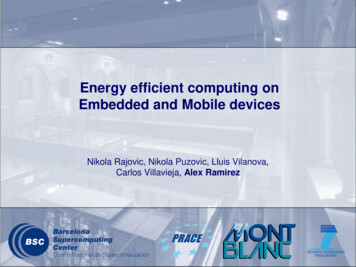
Transcription
Energy efficient computing onEmbedded and Mobile devicesNikola Rajovic, Nikola Puzovic, Lluis Vilanova,Carlos Villavieja, Alex Ramirez
A brief look at the (outdated) Top500 list Most systems are built on general purpose multicore chips Backwards compatibility Programmer productivity2
A brief look at the (soon to be outdated) Green500 list Most of the Top10 systems rely on accelerators for energy efficiency ATI GPU Nvidia GPU IBM PowerXCell 8i3
Some initial assertions You may disagree, but bear with me Power distribution 5% Power Supply 10% Cooling Direct water 10% Interconnect Not always active 10% Storage Not always active 32.5% Memory 32.5% Processor4
Now, some arithmetic (and some assumptions) Objective: 1 EFLOPS on 20 MWatt Blade-based multicore system design 8 ops/cycle @ 2GHz 16 GFLOPSRack:100 compute nodes200 chips300.000 cores4.8 PFLOPS72 Kwatts / rack1 EFLOPS / 16 GFLOPS 100 blades / rack2 sockets / blade150 Watts / socketCPU Multi-core chip:150 Watts24 TFLOPS16 GFLOPS / core1500 cores / chip0.10 Watts / core62.5 M cores32% of 20 MWatt 6.4 MWatt 6.4 MWatt / 62.5 M cores0.10 Watts / core.150 Watt / socket1500 cores / socket24 TFLOPS / socket. . .5Exaflop system:210 racks21.00 nodes62.5 M cores1.000 PFLOPS20 MWatts
Where are we today? IBM BG/Q Fujitsu Ultrasparc VIIIfx 1 ops / cycle @ 800 MHz - 2 GHz0.25 - 1 WattARM Cortex-A15 448 CUDA coresARM Cortex-A9 8 ops / cycle @ 2GHz8 cores / chip12 Watts / coreNvidia Tesla C2050-2070 8 ops/cycle @ 1.6 GHz16 cores / chip 16K cores / rack 2.5 Watt / core4 ops / cycle @ 1 - 2.5 GHz*0.35 Watt*All is there but not together?* Estimated from web sources, not an ARM Commitment6
Can we build supercomputers from embedded technology? HPC used to be the edge of technology First developed and deployed for HPCThen used in servers and workstationsThen on PCsThen on mobile and embedded devices Can we close the loop?7
Energy-efficient prototype series @ BSC200 PFLOPS10 MWatt20 GF/W50 PFLOPS7 MWatt7 GF/W3.5 GF/W1024 nodes152 TFLOPS20 Kwatt256 nodes512 GFLOPS1.7 Kwatt0.2 GF/W20112012201320142015 Start from COTS components Move on to integrated systems and custom HPC technology820162017
Tegra2 prototype @ BSC Deploy the first large-scale ARM cluster prototype Built entirely from COTS components Exploratory system to demonstrate Capability to deploy HPC platform based on low-power components Open-source system software stack Enable early software development and tuning on ARM platform9
ARM Cortex-A9 multiprocessor Energy-efficient applicationprocessor Up to 4-core SMT Full cache coherency VFP Double-Precision FP 1 ops / cycle10
Nvidia Tegra2 SoC Dual-core Cortex-A9 @ 1GHz VFP for DP (no NEON) 2 GFLOPS (1 FMA / 2 cycles) Low-power Nvidia GPU OpenGL only, CUDA not supported Several accelerators Video encoder-decored Audio processor Image processor ARM7 core for power management 2 GFLOPS 0.5 Watt11
SECO Q7 Tegra2 Carrier board Q7 Module 1x Tegra2 SoC 2x ARM Cortex-A9, 1 GHz 1 GB DDR2 DRAM 100 Mbit Ethernet PCIe 1 GbE MXM connector for mobile GPU 4" x 4" Q7 carrier board 2 USB ports 2 HDMI 1 from Tegra 1 from GPU uSD slot 8" x 5.6" 2 GFLOPS 4 Watt12
1U multi-board container Standard 19" rack dimensions 1.75" (1U) x 19" x 32" deep 8x Q7-MXM Carrier boards 8x Tegra2 SoC 16x ARM Cortex-A9 8 GB DRAM 1 Power Supply Unit (PSU) Daisy-chaining of boards 7 Watts PSU waste 16 GFLOPS 40 Watts13
Prototype rack Stack of 8 x 5U modules 4 Compute nodes 1 Ethernet switch Passive cooling Passive heatsink on Q7 Provide power consumptionmeasurements Per unit Compute nodes Ethernet switches Per container Per 5U 512 GFLOPS 1.700 Watt 300 MFLOPS / W 60% efficiency 180 MFLOPS / W14
Manual assembly of board container15
Manual assembly of containers in the rack interconnect wiring16
System software stack Open source system software stackOmpSs compiler Linux OS GNU compiler gcc 2.4.6 gfortran Scientific libraries ATLAS, FFTW, HDF5 Cluster managementMercuriumGNU compilersgccgfortranScientific LibrariesATLAS FFTW HDF5 Runtime librariesPerformance analysisParaver MPICH2, OpenMPI OmpSs toolchainScalasca Performance analysis toolsRuntime librariesNANOS Paraver, ScalascaMPICH2 Allinea DDT 3.1 debuggerCluster ManagementslurmGridEngineLinux OS17
Processor performance: DhrystoneEnergy (J)NormalizedTegra 2110.61.0Core i7116.81.056 Validate if Cortex-A9 achieves the ARM advertised Dhrystone performance 2.500 DMIPS / GHz Compare to PowerPC 970MP (JS21, MareNostrum) and Core i7 (laptop) 2x slower than ppc970 9x slower than i718
Processor performance: SPEC CPU 2006 Compare Cortex-A9 @ 1 GHz CPU performance with 3 platforms ppc970 @ 2.3 GHz Core2 @ 2.5 GHz Core i7 @ 2.8 GHz 2-3x slower 5-6x slower 6-10x slower( if we factor in freq.)(2-4x slower if we factor freq.) Is it more power efficient?19
Energy to solution: SPEC CPU 2006 Tegra2 not always more power-efficient than Core i7 i7 efficiency is better for benchmarks where it outperforms A9 by 10x20
Node performance: Linpack Standard HPL, using ATLAS library ATLAS microkernels also achieve 1 GFLOPS peak performance 1.15 GFLOPS 57% efficiency vs. peak performance 200 MFLOPS / Watt In line with original predictions21
Cluster performance: Linpack 24 nodes 32 nodes 3 x 8 boards (48 GFLOPS peak) 1 GbE switch 4 x 8 boards (64 GFLOPS peak) 1 GbE switch 27.25 GFLOPS on 272 Watts runs don’t complete due toboards overheating 57% efficiency vs. peak 100 GFLOPS / Watt Boards too close together No space for airflow Small problem size (N) 280 MB / node Power dominated by GbE switch 40 W when idle, 100-150 W active22
Lessons learned so far Memory interconnect dominatespower consumption Need a balanced system design Tuning scientific libraries takes time effort! Compiling ATLAS on ARM CortexA9 took 1 month Linux on ARM needs tuning for HPC CFS scheduler softfp vs. hardfp DIY assembly of prototypes isharder than expected 2 Person-Month just to press screws Even low-power devices needcooling It’s the density that matters23
ARM mobile GPU prototype @ BSCRack:32x Board container256x Q7 carrier boards1024x ARM Corext-A9 Cores256x GT520MX GPU8x 48-port 1GbE LBA switchesTegra3 GeForce 520MX:4x Corext-A9 @ 1.5 GHz48 CUDA cores @ 900 MHz148 GFLOPS 18 Watts38 TFLOPS 5 Kwatt7.5 GFLOPS / W 8 GFLOPS / W50% efficiency3.7 GFLOPS / W Validate the use of energy efficient CPU compute accelerators ARM multicore processors Mobile Nvidia GPU accelerators Perform scalability tests to high number of compute nodes Higher core count required when using low-power components Evaluate impact of limited memory and bandwidth on low-end solutions Enable early application and runtime system development on ARM GPU24
What comes next?http://www.montblanc-project.euEuropean Exascale approachusing embedded power-efficient technology1.2.3.To deploy a prototype HPC system based on currently available energyefficient embedded technologyTo design a next-generation HPC system and new embedded technologiestargeting HPC systems that would overcome most of the limitationsencountered in the prototype systemTo port and optimise a small number of representative exascale applicationscapable of exploiting this new generation of HPC systems25
Integrate energy-efficient building blocks Integrated system design built frommobile / embedded components ARM multicore processors Nvidia Tegra / Denver, Calxeda, MarvellArmada, ST-Ericsson Nova A9600, TIOMAP 5, Low-power memories Mobile accelerators Mobile GPU Nvidia GT 500M, Embedded GPU Nvidia Tegra, ARM Mali T604 Low power 10 GbE switches Gnodal GS 256 Tier-0 system integration experience BullX systems in the Top10Mont-Blanc ICT-28877726
Hybrid MPI OmpSs programming model Hide complexity from programmerRuntime system maps task graph toarchitectureAutomatically performsoptimizations Many-core accelerator exploitationAsynchronous communication Overlap communication computationAsynchronous data transfers Overlap data transfer computationStrong scaling Sustain performance with lowermemory size per coreLocality management Optimize data movementMont-Blanc ICT-28877727
Trade off bandwidth for power in the interconnect Hybrid MPI SMPSs Linpack on 512 processors 1/5th the interconnect bandwidth, only 10% performance impact Rely on slower, but more efficient network?28
Energy-efficient prototype series @ BSC200 PFLOPS10 MWatt20 GF/W50 PFLOPS7 MWatt7 GF/W3.5 GF/W1024 nodes152 TFLOPS20 Kwatt256 nodes512 GFLOPS1.7 Kwatt0.2 GF/W2011201220132014 A very exciting roadmap ahead Lots of challenges, both hardware and software!29201520162017
100 blades / rack 2 sockets / blade 150 Watts / socket CPU 8 ops/cycle @ 2GHz 16 GFLOPS 1 EFLOPS / 16 GFLOPS 62.5 M cores 32% of 20 MWatt 6.4 MWatt 6.4 MWatt / 62.5 M cores 0.10 Watts / core 150 Watt / socket 1500 cores / socket 24 TFLOPS / socket Rack: 100 compute nodes 200 chips 300.000 cores 4.8 PFLOPS











